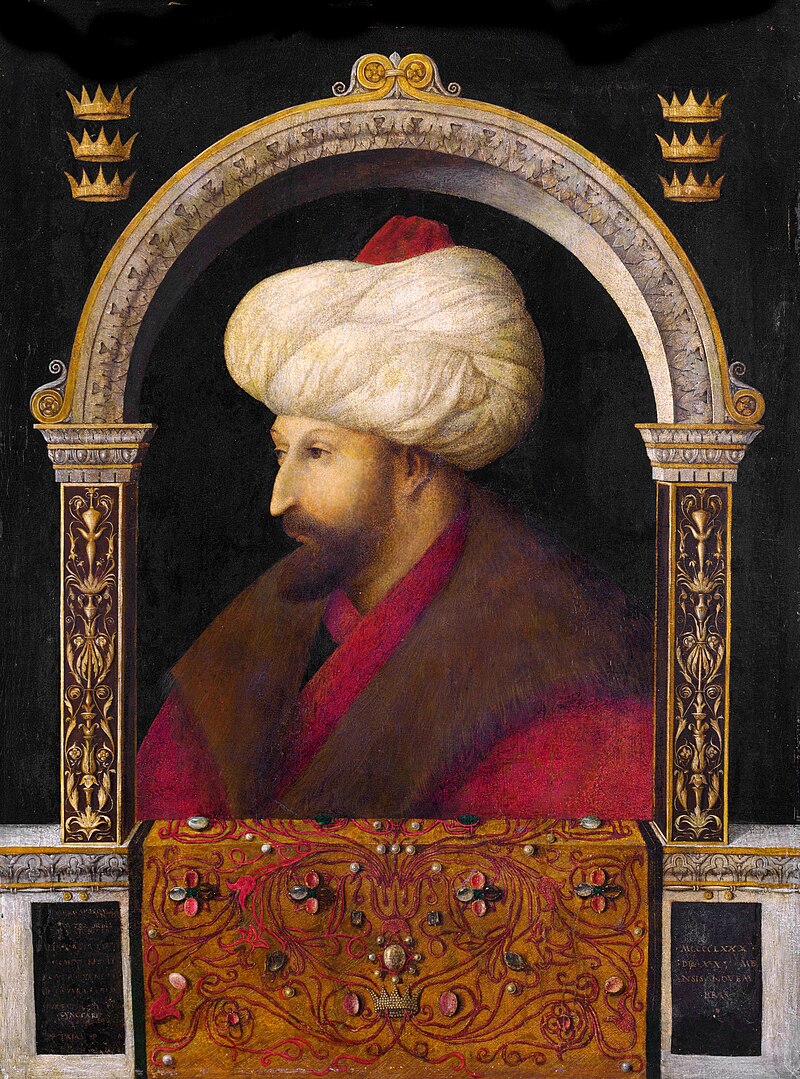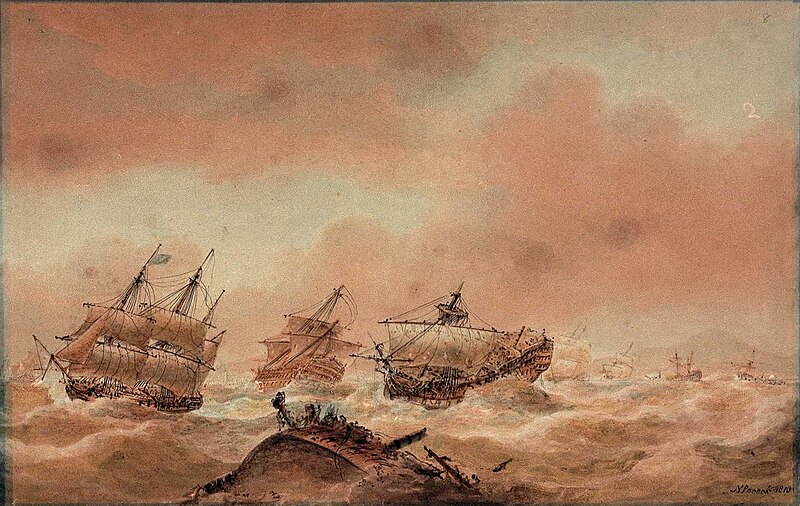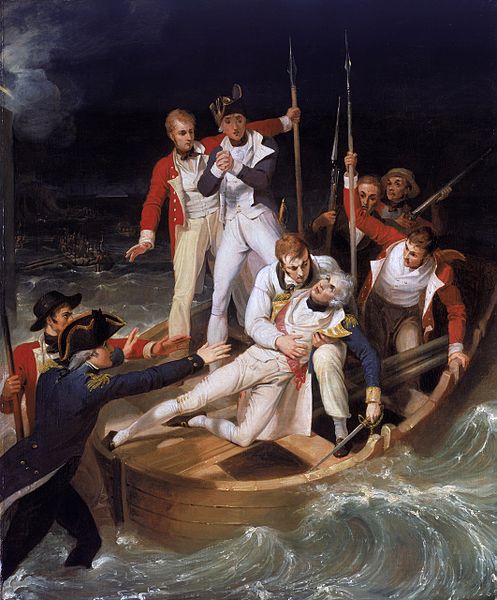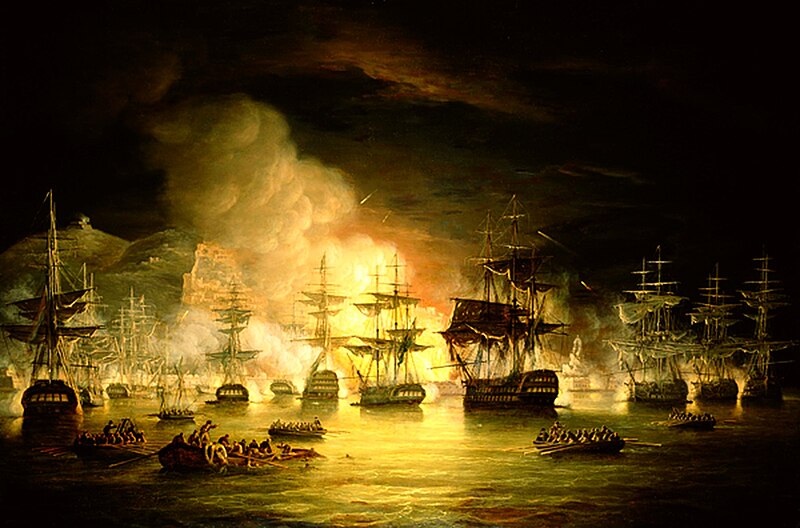Philippe-Jacques van Bree, ANTWERP 1786 - 1871 BRUSSELS, BELGIUM SCHOOL
PHILIPPE-JACQUES VAN BREE; GIOVANNI BELLINI IN MAHOMET II'S COURT
Oil heightened with gold on panel
58.5 x 73.5 cm; 23 by 29 3/4 in
Private collection
Sultan Mohammed II, famous conqueror who besieged and captured Constantinople in 1453, was an avid collector of works of art. He brought the famous Venetian painter Gentile Bellini (circa 1429-1507) in Constantinople, on the occasion of the peace agreements signed between the Republic of Venice and the Ottoman Empire in 1479. On that occasion, the famous Bellini executed portrait Mahomet II, now preserved in the National Gallery in London. More, (See below)
Philippe-Jacques van Bree (1786 - 1871), scholar of his brother Mattheas, was born at Antwerp in 1786. He studied at Antwerp, in Paris (where he became a scholar of Girodet), and at Rome; and also visited Germany and England. He employed himself on historical, fancy, and architectural subjects. Of the last, the Belgian Government purchased his 'View of the Interior of the Church of St. Peter at Rome,' and presented him with a gold medal in addition to the price. He was made conservator of the Museum at Brussels, where he died in 1871. More on Philippe-Jacques van Bree
Gentile Bellini (1429–1507)
The Portrait of Ottoman Sultan Mehmed the Conqueror by İtalian painter Gentile Bellini, c. 1480.
Oil on canvas
Height: 69.9 cm (27.5 in). Width: 52.1 cm (20.5 in).
National Gallery
The attribution to Bellini is not proved, but the sitter is reasonably identified as Mehmet II (1432 - 1481). Gentile Bellini visited his court in Constantinople. There is insufficient evidence for deciding whether the picture is a copy or a very damaged original."
Mehmed II, byname Fatih Sultan Mehmed (Turkish: Sultan Mehmed the Conqueror), (born March 30, 1432, Adrianople, Thrace, Ottoman Empire—died May 3, 1481, Hunkârçayırı, near Maltepe, near Constantinople), Ottoman sultan from 1444 to 1446 and from 1451 to 1481. A great military leader, he captured Constantinople and conquered the territories in Anatolia and the Balkans that constituted the Ottoman Empire’s heartland for the next four centuries. More on Mehmed II
Giovanni Bellini (c. 1430 – 26 November 1516) was an Italian Renaissance painter, probably the best known of the Bellini family of Venetian painters. His father was Jacopo Bellini, his brother was Gentile Bellini (who was more highly regarded than Giovanni during his lifetime, although the reverse is true today), and his brother-in-law was Andrea Mantegna. He was considered to have revolutionized Venetian painting, moving it towards a more sensuous and colouristic style. Through the use of clear, slow-drying oil paints, Giovanni created deep, rich tints and detailed shadings. His sumptuous coloring and fluent, atmospheric landscapes had a great effect on the Venetian painting school, especially on his pupils Giorgione and Titian. More on Giovanni Bellini
Jean-Baptiste Henri Durand-Brager
FRENCH SCHOOL OF NINETEENTH CENTURY
WOMEN AND CHILDREN IN A COURTYARD
Watercolour on paper
48 x 39.5 cm; 18 7/8 by 15 1/2 in
Private collection
Art historian Marion Vidal-Bue was born and lived in Algiers until its independence. She comes from a family of builders established in the country in 1832. She has written books on painters of Algeria, especially to witness the artistic importance and influence of her native country at the time of the French presence.
She participated in the artistic illustration of the works of the Scientific Exploration of Algeria, published in 1844-1867, commissioned by the Minister of War in 1837. These watercolours form a rare and interesting set which shows scenes of life in Algiers 1830-1840 years; in the early days of the arrival of the French in Algeria.
Jean-Baptiste Henri Durand-Brager
WOMEN IN AN INTERIOR WITH NURSE CONCERNED FOR A BABY
Watercolour on paper
48 x 39.5 cm; 18 7/8 by 15 1/2 in
Private collection
Jean-Baptiste Henri Durand-Brager (1814–1879) was a French painter, noted for his marine scenes and Orientalist works.
Durand-Brager, a French marine painter, was born at Dol in Brittany in 1814. He studied under Gudin and Eugène Isabey.
He was a naval officer who rose to the rank of captain. In 1840, he accompanied the fleet which repatriated Napoleon's remains from St. Helena, which island afforded him subjects for various pictures. He spent much of his time in travelling; he went to Buenos Aires with the squadron, Montevideo in 1841–42 aboard a French warship, and explored Uruguay and Brazil; he accompanied the expeditions to Tangiers and Mogador, and to Madagascar. He painted views of the places he visited, and also naval combats and sea-pieces. He died in 1879.
In the 1850s, he was in the Crimea during the war with Russia, where he turned his hand to photography as well as painting. He was one of about fifteen photographers, including Felice Beato, Roger Fenton and James Robertson, who photographed soldiers, barracks, camp life and battlefields and were the first to record a major war on film. Later, he returned to Constantinople where he made photographs of the landscape, monuments and the people.
He was a versatile painter, producing naval scenes, genre works, costumbrismo works, landscapes and works with Orientalist themes. There are several of his works in the galleries of Versailles.
More on Jean-Baptiste Henri Durand-Brager

FRENCH SCHOOL OF NINETEENTH CENTURY
SCENE IN A CAFE
Watercolour on paper
48 x 39.5 cm; 18 7/8 by 15 1/2 in
Private collection
FRENCH SCHOOL OF NINETEENTH CENTURY
DANCER AND MUSICIANS
Watercolour on paper
48 x 39.5 cm; 18 7/8 by 15 1/2 in
Private collection
FRENCH SCHOOL OF NINETEENTH CENTURY
RECEPTION BY NIGHT IN A PALACE
Watercolour on paper
48 x 39.5 cm; 18 7/8 by 15 1/2 in
Private collection
FRENCH SCHOOL OF NINETEENTH CENTURY
MUSICIANS AND AFRICAN DANCERS IN THE COURTYARD OF A PALACE
Watercolor on paper
48 x 39.5 cm; 18 7/8 by 15 1/2 in
Private collection
19th-century French School
ACROBATS, Signed lower right Durand
Watercolour on paper
25.5 x 40 cm; 10 by 15 3/4 in
Private collection
Artwork produced in 19th-century France that reflects the teachings of the École des Beaux-Arts, the Parisian state-sponsored art academy. Prioritizing draftsmanship over painting, the school taught students to employ fine line work and soft, blended shading in their drawings. Jean-Auguste-Dominique Ingres’s drawings, such as his portrait of Mrs. Charles Badham, epitomize the Academic style, which is characterized by close attention to detail, near-invisible brushstrokes, and an emphasis on realistic modeling and shading. Academic painters often depicted scenes from history, literature, the Bible, or classical mythology, although this style can also be seen in pastoral scenes. Many of the French Impressionist painters were trained in the Academic style, though they later rejected it in favor of their trademark loose, expressive brushwork and scenes of modern life. More on 19th-century French School
Jean-Leon Gerome
VESOUL 1824 - 1904 PARIS
STUDY FOR A MOORISH BATH, TURKISH WOMAN IN BATH
Oil on canvas
50.5 x 40.5 cm; 20 by 16 in
Private collection
This study is a preparatory sketch for the large painting (81,5 x 65,5cm) A Moorish bath, Turkish woman bathing, painted in the 1870s and kept in a private collection (See Below). There are some other known preparatory studies: a drawing of the same composition and the same dimensions as our sketch and two oil sketches, larger format than the one presented here.
For Gérôme, a good academician, the creative process was primarily intellectual. He reflected on a conception of the final composition, which he then seized on an initial study that was the basis for the further work. This is probably the first study of a Turkish bath, a Turkish woman bathing, which explains its freshness and spontaneity.
Gérôme worked hard on the silhouette and the attitude of the nude bather.
In all known studies to a Turkish bath, a Turkish woman bathing, the African servant is outlined. It is only in the finished work that the face appears clearly.
Gérôme tried to create an intense psychological relationship between bather's surprise at a specific time of her dress, and her maid; he is leaning over the basin, hands resting on the edge, tense, waiting impatiently for the moment when she will feel, just out of the bath, the delicious sensation of cold foam soap.
Studies and sketches of Gerome oils were often completed by other painters, to make them more commercial. Our sketch was lucky to escape the retouching and remain intact, unaltered and entirely Gérôme's hand. More on this painting
Jean-Léon Gérôme (11 May 1824 – 10 January 1904) was a French painter and sculptor in the style now known as Academicism. The range of his oeuvre included historical painting, Greek mythology, Orientalism, portraits and other subjects, bringing the Academic painting tradition to an artistic climax. He is considered one of the most important painters from this academic period, and in addition to being a painter, he was also a teacher with a long list of students. More on Jean-Léon Gérôme
Jean-Leon Gerome
VESOUL 1824 - 1904 PARIS
A MOORISH BATH, TURKISH WOMAN IN BATH, 1885
The final painting
Private collection
Frederik-Jan-Pieter Portielje, AMSTERDAM 1829 - 1895 ANTWERP, DUTCH SCHOOL
YOUNG LADY WEARING A MIDDLE-EASTERN COSTUME
Oil on panel
59 x 48 cm; 23 1/4 by 18 7/8 in
Private collection
Jan Frederik Pieter Portielje (Amsterdam, 1829 - 1908) was a Dutch-Belgian painter. He was the tenth child by Gerrit Portielje, bookseller and publisher in Amsterdam, and Jacoba Zeegers. He studied at the Academy of Amsterdam from 1842 to 1849 with, among others, Valentine Bing and Jan von Braet Uberfeldt. Between 1851 and 1853 he stayed several times for extended periods of time in Paris, possibly during the summer months when the Academy was closed due to holidays. He also worked as a portraitist and as such had a growing clientele in Brussels and Antwerp.
His oeuvre includes portraits, scenes of elegant ladies in gardens, parks, or luxurious interiors. The interiors are either heavy or elegant neo-Baroque Napoleon III. He painted Western and Southern or Oriental women, often adorned with jewels. His painting are realistic, with an eye for detail and texture, intended as an elegant genre painting without much depth.
On some paintings he collaborated with another artist. There are paintings known, together with Frans Lebret (1820-1909) and Eugène Remy Maes (1849-1931).
After his studies Portielje remained in Antwerp. He married there in 1853. More on Jan Frederik Pieter Portielje

Emile Régnault de Maulmain
LONS-LE-SAUNIER 1836 - 1897 NEVY-SUR-SEILLE
MARKET SCENE IN A STREET
Oil on canvas
55.5 x 40.8 cm; 21 7/8 by 16 in
Private collection
Emile Regnault de Maulmain
LONS-LE-SAUNIER 1836 - 1897 NEVY-SUR-SEILLE
THE REST IN THE OASIS
Oil on canvas
47 x 73 cm; 18 1/2 by 28 3/4 in
Private collection
Maulmain Emile Regnault, 1836-1897, French school. Maulmain was a pupil of Miss Lamotte Lobrichon and Alberto Pasini. He exhibited at the Salon from 1863 until 1882, especially scenes of Algeria.
Georges Washington
MARSEILLE 1827 - 1910 PARIS
BATTLE SCENE;
Signed lower left G. Washington
Oil on canvas
46 x 55 cm; 18 1/8 by 21 2/3 in
Private collection
George Washington, born 15 September 1827 in Marseille and died November 19, 1901 in Douarnenez, was a French Orientalist painter. Like most aspiring artists, the young Georges Washington moved to Paris, where he trained at the Ecole des Beaux Arts under François-Edouard Picot (1786-1868). The artist’s exotic style was also indebted to Eugène Delacroix (1798-1863). Washington’s art conveys a similar feeling to the work of Eugène Fromentin (1820-76) who often painted naturalistic Middle Eastern scenes of rural and nomadic life. Washington’s love of the Middle East and its customs was further enhanced and encouraged by his father-in-law, the military and Orientalist painter Henri-Félix-Emmanuel Philippoteaux (1815-1884), whose daughter Anne-Léonie Philippoteaux married Washington in Paris on 6th August 1859.
Not long after finishing his training at the Ecole des Beaux Arts, Washington embarked on the first of a number of trips to Algeria and based on close observation of its inhabitants, their dress and customs in 1857 he made his Paris debut at the Salon des Artistes Français with a view of nomads titled Plaine du Hoiina (Sahara Algérien). From then up until 1901 Washington continued to be a popular exhibitor at the Salon; one of his first works shown there to gain critical acclaim was Nomades dans le Sahara en Hiver. In addition to Paris, Washington also showed his work in Moscow in 1881 and was later posthumously honoured when four of his paintings were included in the Exposition Coloniale de Marseille in 1906.
Following two commissions from a Belgian company, he travelled to Morocco and then subsequently visited Hungary, Bulgaria and Turkey, which were to inspire his varied subjects including battle scenes and cavalry skirmishes. His travels also took him to America for the unveiling in Philadelphia of a cyclorama (a monumental 360° panoramic view) of the Battle of Gettysburg by his brother-in-law Paul-Dominique Philippoteaux (1846-1923).
Following the death of his wife he retired to live with his daughter and son-in-law at Douarnenez on the Brittany coast, where he died shortly after on 19th November 1901.
More George Washington

Henri Rousseau, CAIRO 1875 - 1933 AIX EN PROVENCE
THE FANTASIA OF NEMENCHAS, ALGERIA
Oil on canvas
65 x 92 cm; 25 5/8 by 36 1/4 in
Private collection
Rousseau creates a fantasy he chooses to place on the plateau of Nemenchas, Algeria. The tight framing on the group of riders launched in full immerses the viewer in the scene. The proximity thus created communicates a feeling of intense movement. The determination and pride of the riders and their horses, some of which rear up in a frenzy, is beautifully rendered in vibrant color buttons.
Henri Rousseau Henry, Emilien Rousseau (Cairo 1875 - Aix-en-Provence in 1933) is an Orientalist painter. A pupil of Jean-Léon Gérôme at the Beaux Arts in Paris, he won the second Grand Prix de Rome in 1900 and a travel grant at the Salon of French Artists. He traveled to Belgium, the Netherlands, North Africa, Spain and Italy where he admired the great masters (Rubens, Rembrandt, Velasquez, Murillo, the Titian, Raphael etc ...)
After this initiatory journey, he settled in Versailles and set up his studio at the Villa des Arts in Paris. In 1919 he moved to Aix in Provence with his large family (seven children). Knight of the Legion of Honour in arts. His work is dedicated to Tunisia, Algeria and especially Morocco, Provence and the Camargue remained its anchor points. His success was with a bourgeois and wealthy clientele, where he sold his work at numerous exhibitions in Paris, Brussels, Stockholm, Marseilles. More on Henri Rousseau

Jules-Pierre van Biesbroeck, PORTICI 1873 - 1965 BRUXELLES, ECOLE BELGE
WOMAN CARRYING AN AMPHORA
Oil on panel
58 x 32.4 cm; 22 4/5 by 12 1/4 in
Private collection
Jules Pierre van Biesbroeck was born in Italy in 1873. His father was the Belgian painter Jules Evariste van Biesbroeck and like many artists of his time, he was working in Italy when his son Jules was born. The child was two years old when the family returned to Ghent.
After a short period of practice with his father, van Biesbroeck was enrolled in the Academy of Fine Arts in Ghent. He was a child prodigy and sold his first painting at the age of 14 during the Triennale Ghent Exhibition. In 1888, when he was 15 years old, he made his debut at the Salon des Champs-Elysées in Paris with a monumental canvas which stood out because of his nude models. The canvas scandalized the censors and the young artist was asked to cover his figures with drapery before the painting could be exhibited. The jury gave Van Biesbroeck an honorable mention on the recommendation of William Bouguereau. Van Biesbroeck won fame in sculpture as well as paintings and was rewarded with many commissions for the city of Ghent.
When German troops invaded Belgium during World War I, Van Biesbroeck went to Bordighera in Italy where he continued to paint and sculpt. In 1926 he made a trip to North Africa, then in 1927, he visited Algeria. The light and atmosphere of Maghreb caused him to change his palette and employ lighter colors and represent orientalist subjects, particularly the inhabitants of Bou-Saada. Algiers had such an influence on the artist, that he lived there for nine years. In 1938 he returned to Ghent, and continued to paint orientalist works. Portrait of a Blind Arab dates from Van Biesbroeck’s early period in Algeria.
More on Jules Pierre van Biesbroeck

Attributed to George Derville Rowlandson, 1861 - 1928, ENGLISH SCHOOL
CAVALIERS COMING OUT OF A FORTIFIED GATE, c. 1888
Oil on canvas
83.5 x 61 cm; 32 7/8 by 24 in
Private collection
George Derville Rowlandson (1861–1928) was a British painter. He is best known for his equestrian portraits. Some of his work can be found at the Museum of Polo and Hall of Fame in Lake Worth, Florida.
Rowlandson was born in India in 1861 and studied art at Gloucester Art School, Westminster and Paris. He exhibited at the Royal Institute of Painters in Watercolour between 1911 and 1918 from 22 Priory Road, Bedford Park, London. He contributed illustrations to The Illustrated London News and the English llustrated Magazine, his work being mostly military or equestrian subjects, and a number of hunting scenes. More on George Derville Rowlandson
Emmanuel Dieudonné GENEVA 1845 - 1889, SWISS SCHOOL OF NINETEENTH CENTURY
THE SLAVE MERCHANT
Oil on canvas, unframed
42 x 61 cm; 16 1/2 by 24 in
Private collection
This is a preparatory sketch for the large painting, signed lower left E. DIEUDONNE, kept at the National Federation of André Maginot, Paris. A pupil of Cabanel, Emmanuel Dieudonné exhibited at the Salon from 1876. He made many Orientalists compositions. 























